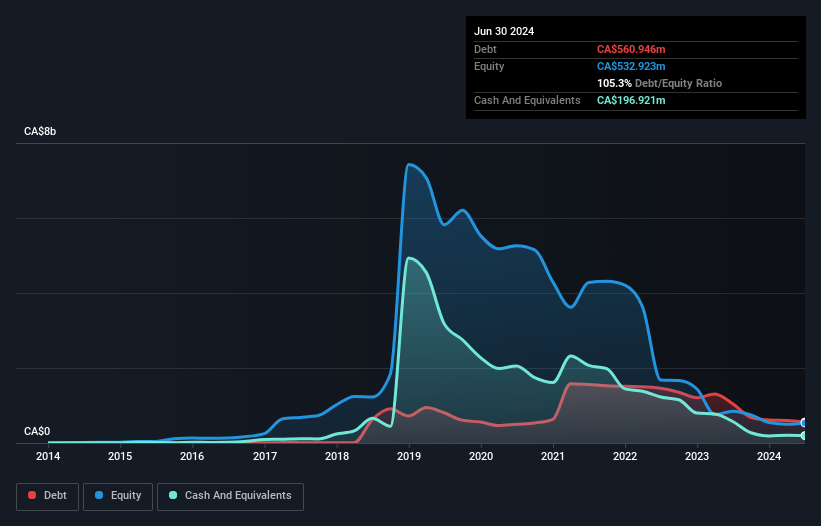Some say volatility, rather than debt, is the best way to think about risk as an investor, but Warren Buffett famously said that 'Volatility is far from synonymous with risk.' So it seems the smart money knows that debt - which is usually involved in bankruptcies - is a very important factor, when you assess how risky a company is. Importantly, Canopy Growth Corporation (TSE:WEED) does carry debt. But is this debt a concern to shareholders?
What Risk Does Debt Bring?
Debt and other liabilities become risky for a business when it cannot easily fulfill those obligations, either with free cash flow or by raising capital at an attractive price. If things get really bad, the lenders can take control of the business. However, a more frequent (but still costly) occurrence is where a company must issue shares at bargain-basement prices, permanently diluting shareholders, just to shore up its balance sheet. Of course, debt can be an important tool in businesses, particularly capital heavy businesses. When we think about a company's use of debt, we first look at cash and debt together.
Check out our latest analysis for Canopy Growth
What Is Canopy Growth's Net Debt?
You can click the graphic below for the historical numbers, but it shows that Canopy Growth had CA$560.9m of debt in June 2024, down from CA$1.05b, one year before. However, it does have CA$196.9m in cash offsetting this, leading to net debt of about CA$364.0m.

A Look At Canopy Growth's Liabilities
According to the last reported balance sheet, Canopy Growth had liabilities of CA$166.6m due within 12 months, and liabilities of CA$586.7m due beyond 12 months. On the other hand, it had cash of CA$196.9m and CA$50.9m worth of receivables due within a year. So its liabilities outweigh the sum of its cash and (near-term) receivables by CA$505.5m.
This deficit is considerable relative to its market capitalization of CA$814.6m, so it does suggest shareholders should keep an eye on Canopy Growth's use of debt. Should its lenders demand that it shore up the balance sheet, shareholders would likely face severe dilution. The balance sheet is clearly the area to focus on when you are analysing debt. But it is future earnings, more than anything, that will determine Canopy Growth's ability to maintain a healthy balance sheet going forward. So if you're focused on the future you can check out this free report showing analyst profit forecasts.
In the last year Canopy Growth had a loss before interest and tax, and actually shrunk its revenue by 9.5%, to CA$287m. We would much prefer see growth.
Caveat Emptor
Over the last twelve months Canopy Growth produced an earnings before interest and tax (EBIT) loss. Indeed, it lost a very considerable CA$106m at the EBIT level. When we look at that and recall the liabilities on its balance sheet, relative to cash, it seems unwise to us for the company to have any debt. So we think its balance sheet is a little strained, though not beyond repair. Another cause for caution is that is bled CA$191m in negative free cash flow over the last twelve months. So in short it's a really risky stock. When analysing debt levels, the balance sheet is the obvious place to start. But ultimately, every company can contain risks that exist outside of the balance sheet. These risks can be hard to spot. Every company has them, and we've spotted 3 warning signs for Canopy Growth you should know about.
When all is said and done, sometimes its easier to focus on companies that don't even need debt. Readers can access a list of growth stocks with zero net debt 100% free, right now.
New: AI Stock Screener & Alerts
Our new AI Stock Screener scans the market every day to uncover opportunities.
• Dividend Powerhouses (3%+ Yield)
• Undervalued Small Caps with Insider Buying
• High growth Tech and AI Companies
Or build your own from over 50 metrics.
Have feedback on this article? Concerned about the content? Get in touch with us directly. Alternatively, email editorial-team (at) simplywallst.com.
This article by Simply Wall St is general in nature. We provide commentary based on historical data and analyst forecasts only using an unbiased methodology and our articles are not intended to be financial advice. It does not constitute a recommendation to buy or sell any stock, and does not take account of your objectives, or your financial situation. We aim to bring you long-term focused analysis driven by fundamental data. Note that our analysis may not factor in the latest price-sensitive company announcements or qualitative material. Simply Wall St has no position in any stocks mentioned.
About TSX:WEED
Canopy Growth
Engages in the production, distribution, and sale of cannabis, hemp, and cannabis-related products in Canada, Germany, and Australia.
Excellent balance sheet with slight risk.
Similar Companies
Market Insights
Community Narratives




